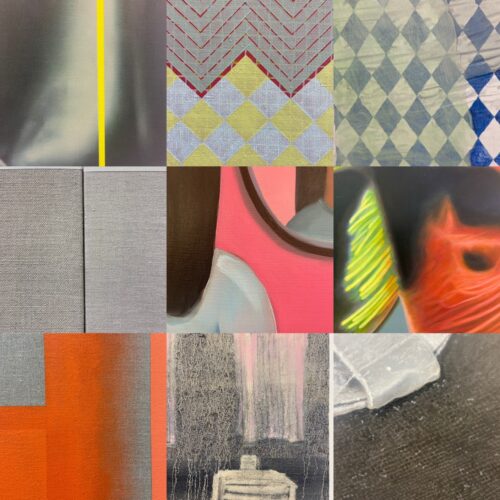
From Whistler to Wallinger
An OCA student, Delia Hiscock Walker, reports on her day out at Tate Britain with a bunch of other students and the guidance of an OCA art tutor.
‘I have a lingering phrase in my head from this successful and very well organised study day on 2nd July. It’s this : ‘Just paint….’ commented our tutor, Jim Cowan, summarising how artists achieve uniqueness, forge huge conceptual leaps, explore new techniques and materials that are packed with meaning. There were lots of valuable facts and insights during the day (some contributed by members of the group) anecdotes about artists, their working methods, personal ideas and many questions raised and discussed. 
Such humour and energetic banter meant that we spent a very enjoyable day. The theme of day: ‘Whistler to Wallinger’ helped us to see very clear links between artists, cultures, places and events of the time. This was not a whistle stop tour. There was time to think about the context of Stanley Spencer and his work, as there was of the inventively powerful social commentary of Bill Woodrow’s 1981 ‘Indian Headress and Twin Tubs.’ Interestingly, we learned how the transitional or development phases between artistic periods were explicit in discrete works of art. Viewing Pauline Boty’s 1962 painting ‘The Only Blonde in the World’, and Mark Wallinger ‘s 2000 video, ‘Threshold to the Kingdom’ were just two that indeed leapt out at us. There are many more. Several of us were mesmerised by Peter Doig’s painting ‘Echo’ and studied the beauty of the paint handling.
After lunch, when some of the group popped into the Watercolourists or contemporary exhibitions, following up personal interests, re -visiting works through sketching and discussing works that spoke to us. Our final get together and reflections revealed some remarkably good drawing, analysis and insight into the artistic process. I felt that the courses entitled ‘Exploring Concepts’ and ‘Finding One’s Way’ hold a greater resonance now.’
http://deesartscape.blogspot.com/
Jim Cowan also reports on the day and the Tate’s New British hang. 
The realism of Stanley Spencer’s masterpiece ‘The Artist and his Second Wife (the leg of mutton nude) of 1937, shows Spencer’s influence on later artists such as Lucien Freud. As if to complement this work, a small painting by Hilda Carline (Spencer’s first wife) of the River Thames at Cookham was also on display.
It was good to see that some lesser known and neglected British artists were now being welcomed onto the walls of the Tate alongside their better known colleagues and the students could see that this was indeed beginning to happen. 
Pop Artist Pauline Boty, the only female pop artist to come out of the Royal C ollege has been forgotten since the 1960s, but now she is on display with her groundbreaking painting of Marylyn Monroe and there were a number of other relatively unknown names beginning to appear on the walls. This allows for a larger and richer history of British art to emerge.
The new hang is strong in some areas, weak in others. The Bloomsbury’s artists are next to the Vorticists’, the official war artists with the pacifists. It was interesting to see that the two best paintings inspired by the two World Wars Mark Gertler’s ‘Merry Go Round’ and Francis Bacons ‘Study for Three Figures at the base of a Crucifixion.’ are both on display, both having been painted by ‘conscientious objectors’.
The afternoon session was an opportunity to draw from the collection and to annotate sketchbooks. By far the most popular picture to draw from was Richard Hamilton’s ‘ Homage a Chrysler Corp’ (created in 1957): this painting, a comment on the advertising industries love of promoting fast cars and women, combined a variety of styles and materials and heralds the beginning of the Pop Art movement that emerged out of the Royal College in the 1960s. 
For sculpture enthusiasts, Bill Woodrow’s ‘Car Door, Ironing Board and Twin Tub with North American Indian Headdress ‘ (1981) was an essay in recycling that made a statement about how one culture can be overtaken and subsumed into another.
The tour ended with a viewing of Mark Wallinger’s ‘ Threshold to the Kingdom’ (2000). This piece is a good introduction to students unfamiliar with video art as Wallinger’s gentle humor and acute observational eye is brought to bare on a procession of airport arrivals accompanied by the music of Allegries ‘Misereri’.






Sounds like a memorable day all around. Interesting that Peter Doig’s “Echo” was on display, it was in storage last year when I was there. Is that “Echo” or “Echo Lake” by the way? I don’t recognise anyone in the group alas (except JC) . . . and who took the photo? Two great posts for the price of one, thanks for sharing.
I thought it was an excellent day. It was the first time I had a proper look around, normally when I visit Tate Britain I will visit a specific exhibition then leave. I have been back twice since, to draw and to take in the works. The day was also great for meeting other OCA students and tutors.
I’ve been a student with OCA for several years but this was the first study day I’ve attended.
The Gertler Merry Go Round and the Sickerts are more meaningful for me now, to mention just two of the artists whose work we saw and following such an informative and enjoyable day I would recommend participation {when the opportunity occurs} to any other students who, like me in the past, might be slightly intimidated at the thought of joining in.
The new ‘hang’ of British Art at Tate Britain presents much that I’ve not seen before {except in reproduction} although I missed the Matthew Smiths. the Bombergs and the Pasmores.
Thank you Jim for the facts and the humour — it was an excellent day.
The most important movement in 20th century art was British, according to Dr James Fox, in his British Masters programmes on BBC 4, Mondays 9pm, so a visit to Tate Britain is an absolute must, even if the claim seems a little surprising bearing in mind the competition: Cubism, Expressionism, Fauvism, Dada and the Bauhaus.
The British Masters programme is to be applauded for highlighting the work of Sickert, Paul Nash, Stanley Spencer and others. As artists they are not short of exhibitions and their places are secure in the story of art in the 20th Century art in this country. If money is anything to go by then the £5.4 million paid for Spencer’s ‘Sunflower and Dog worship ” 1937 at Southeby’s recently ,indicates his growing international status.
What is new in this programme is that the commentator is not afraid to promote these artists as important figures in British Art and even if they are not considered great masters like Matisse and Picasso ,one should not downgrade their considerable achievements.
However I think I would draw the line at his reassessment of Afred Munnings and his many paintings of horses. I did enjoy hearing again his drunken Royal Academy after dinner speech which did show up the prejudices of the time. If you have not seen this series on BBC4 I would recommend it.
Jim – I think you make a very good point about nor ignoring or belittling artists who’s contribution is to the art of one country, region or genre rather than the whole pantheon of art.
There are a;ways periods when art seems to leap forward in a particular place and lag behind or go off to a dead end in others but that does not mean that the artists who are not at what turns out to be the cutting edge, are not worth investigating.
Munnings on the other hand…!
Visit Britain says
Britain is probably one of the best places to live.